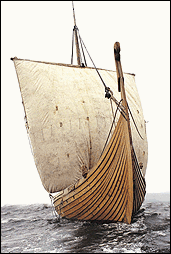|
Vikings:
The North Atlantic Saga
May
8 to October 14, 2002
Fact
Sheet

As
of May 8, 2002, the Canadian Museum of Civilization will be presenting Vikings:
The North Atlantic Saga, an exceptional exhibition shedding light on
the most recent findings by scholars and archaeologists and showcasing
some of the most spectacular artifacts of Viking civilization. This
exhibition is a unique opportunity to learn about the first Europeans to
reach North America and their
contact with the natives of the New World.
Vikings: The North Atlantic Saga,
a groundbreaking exhibition covering 750 square metres (8,000 sq.
ft.), is the work of a team of no less than 15 curators from museums
around the world, directed by Dr. William Fitzhugh, Director of the
Arctic Studies Center at the National Museum of Natural History,
Smithsonian Institution. They have brought together national treasures
and unique collections from nine different countries.
Artifacts:
More
than 300 artifacts dating from A.D. 800 to the present will be
presented, grouping some of the greatest treasures and recent
archaeological discoveries from the Viking Age and
the Mediaeval period which followed. They include a thirteenth- to fourteenth-century Inuit wooden figurine
in European attire, striking evidence of face-to-face contact between
Vikings and Native peoples. They also include elaborate swords inlaid
with silver, a gilded harness bow, an elegant articulated Urnes-style
brooch, an animal-style whalebone “ironing” board, and models of
Viking ships — all artifacts of the Vikings’ everyday life. Other
objects include agricultural tools, carvings in wood and stone,
jewellery, clothing, armour, weaponry and more.
Interesting Facts about the Vikings:
·
Iceland’s
national assembly (named Althing),
founded in A.D. 930, was Europe’s longest running parliament.
·
The
Viking deities Odin, Thor and Freya are remembered every week, lending
their names to Wednesday, Thursday and Friday.
·
The
Vikings created a vast trading network that stretched from Scandinavia as
far as Spain and the Mediterranean to the south, Kiev and Baghdad
to the East, and what is now Canada
to the West.
·
The
Vikings had a complex social organization in which wealth was defined by
position, alliances and connection, rather than by accumulated gold and
silver.
·
Contrary
to popular belief, the Vikings did not have horns on their helmets, an
image popularized by nineteenth-century opera singers.
·
The
Berserkers, literally “bear
shirts,” were the most feared of the Vikings. They worked themselves
into a frenzy before going into battle and fought on, regardless of pain.
·
Skraelings
is the somewhat derogatory name
given by the Vikings to the Native peoples they encountered in
North America and Greenland.
·
Central to the Vikings’
religion was their belief in a large number of gods and goddesses, giants
and dwarves, Valkyries, elves and a variety of spirits who were believed
to play a role in nearly every aspect of life and death.
·
The origin of the word “Viking” is unclear, but
seems to derive from "Vik" meaning “a small harbour”. It
refers to people who kept their seagoing ships in such harbours, from
which they raided European coasts between AD 800 and 1000. Their
Christianized descendants after AD 1000 are referred to as the mediaeval
Norse.
Special Events:
A
wide range of special events is planned in support of the exhibition,
dependent on sponsorship. These include a Viking Fest, a summer solstice
festival, musical and theatrical performances, lectures and educational
programming.
Publication:
Vikings — The North Atlantic Saga,
produced by the Smithsonian Institution (in English only) is available in
the CMC Boutique. Includes colour photographs, drawing and maps; 416 pp.,
$57.95.
Vikings:
The North Atlantic Saga
has been made possible through the generous support of the Nordic Council
of Ministers and Volvo. Additional support has been provided by Husqvarna
Viking Sewing Machines, Barbro Osher Pro Suecia Foundation, and Phillips
Petroleum Company Norway. The exhibition has been organized by the
National Museum of Natural History, Smithsonian Institution. Presented in
partnership with the White House Millennium Council.
Gotha
ferth! (Viking
for “Have a safe journey!”)
|



